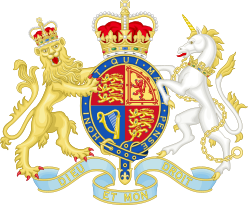William Lamb, 2. Viscount Melbourne

William Lamb, 2. Viscount Melbourne (* 15. März 1779 in London; † 24. November 1848 in Brocket Hall, Hertfordshire) war ein britischer Adliger und Politiker. Er war 1834 und von 1835 bis 1841 britischer Premierminister und gilt als Mentor Königin Victorias. Nach ihm wurde die australische Stadt Melbourne benannt, die Hauptstadt des Bundesstaates Victoria.
Leben
William Lamb war der Sohn von Peniston Lamb, 1. Baron Melbourne (1745–1828), der 1781 zum Viscount Melbourne erhoben wurde, und dessen Frau Elizabeth Millbanke, Tochter des Sir Ralph Milbanke, 5. Baronet. Da seine Mutter viele Affären hatte, ist es nur eine Vermutung, dass George Wyndham, 3. Earl of Egremont sein biologischer Vater war. Er war das älteste von insgesamt fünf Kindern, seine Schwester Emily heiratete 1839 Lord Palmerston.
Von 1806 bis 1812 und von 1816 bis zum Tod seines Vaters 1828, dessen Adelstitel und Sitz im House of Lords er dann erbte, war Melbourne für die Wahlkreise Leominster, Haddington, Portarlington, Peterborough, Hertfordshire und Newport Abgeordneter im House of Commons. Seit 1827 war er Mitglied des Privy Council. Von 1827 bis 1828 war er Chief Secretary for Ireland, von 1830 bis 1834 war er britischer Innenminister (home secretary, 1830–1834). 1834 und von 1835 bis 1841 war er Lord High Treasurer und damit Premierminister.
Familie
1805 heiratete William Lamb Lady Caroline Ponsonby, die als Romanautorin Bekanntheit erlangte und eine Tochter des Frederick Ponsonby, 3. Earl of Bessborough, war. Das einzige Kind dieser Ehe, der 1807 geborene Sohn Hon. George Augustus Frederick Lamb, blieb unverheiratet und starb bereits 1836. Seine Adelstitel erbte sein Bruder Frederick Lamb, 1. Baron Beauvale. 1825 trennte sich William Lamb von seiner Ehefrau nach ihrer skandalösen Affäre mit Lord Byron. Sie starb 1828.
In der Populärkultur
In dem Film Victoria, die junge Königin aus dem Jahr 2009 wurde Melbourne von dem Schauspieler Paul Bettany und in der ITV-Serie Victoria von Rufus Sewell verkörpert.
Im Film Mädchenjahre einer Königin von 1954 wurde Lord Melbourne an der Seite von Romy Schneider als Victoria von Karl Ludwig Diehl gespielt. In der früheren Verfilmung Mädchenjahre einer Königin aus dem Jahr 1936 wird er von Otto Tressler gespielt.
Literatur
- David Cecil: The Young Melbourne & Lord M. Bello, London 2017, ISBN 978-1-5098-5492-9.
- Dick Leonard: William Lamb, second Viscount Melbourne: Mentor to a young monarch. In: Dick Leonard: British Prime Ministers from Walpole to Salisbury. The 18th and 19th centuries. Band 1, Routledge, London 2021, ISBN 978-0-367-46911-5, S. 271–283.
- L. G. Mitchell: Lord Melbourne, 1779-1848. Oxford University Press, Oxford 1997, ISBN 978-0-19-820592-0.
- Melbourne, William Lamb, 2nd Viscount. In: Encyclopædia Britannica. 11. Auflage. Band 19: Mun – Oddfellows. London 1911, S. 80 (englisch, Volltext [Wikisource]).
Weblinks
- Melbourne, Viscount (I, 1781–1853) bei Cracroft’s Peerage
- William Lamb, 2nd Viscount Melbourne auf thepeerage.com
| Vorgänger | Amt | Nachfolger |
|---|---|---|
| Peniston Lamb | Viscount Melbourne 1828–1848 | Frederick Lamb |
| Herbert Taylor | Privatsekretär des Britischen Monarchen (informell) 1837–1840 | Albert von Sachsen-Coburg und Gotha |
| Personendaten | |
|---|---|
| NAME | Lamb, William, 2. Viscount Melbourne |
| ALTERNATIVNAMEN | Melbourne, William Lamb, 2. Viscount |
| KURZBESCHREIBUNG | britischer Politiker, Mitglied des House of Commons, Innen- und Premierminister |
| GEBURTSDATUM | 15. März 1779 |
| GEBURTSORT | London |
| STERBEDATUM | 24. November 1848 |
| STERBEORT | Brocket Hall, Hertfordshire |
Auf dieser Seite verwendete Medien
Autor/Urheber: Sodacan, Lizenz: CC BY-SA 3.0
Royal Coat of Arms of the United Kingdom of Great Britain and Northern Ireland in the style used by the Government of Queen Elizabeth II from 1952 to 2022 (as used in all places except Scotland).
| “ | Quarterly, First and Fourth Gules three lions passant guardant in pale Or armed and langued Azure (for England), Second quarter Or a lion rampant within a double tressure flory counter-flory Gules (for Scotland), Third quarter Azure a harp Or stringed Argent (for Ireland), the whole surrounded by the Garter; for a Crest, the imperial crown Proper; for Supporters, dexter a lion rampant guardant Or crowned as the Crest, sinister a unicorn Argent armed, crined and unguled Proper, gorged with a coronet Or composed of crosses patée and fleurs de lys a chain affixed thereto passing between the forelegs and reflexed over the back also Or; Motto 'Dieu et mon Droit’ ('God and my Right') below the shield. | ” |
- PINCHES, J.H & R.V., The Royal Heraldry of England, 1974, Heraldry Today.

